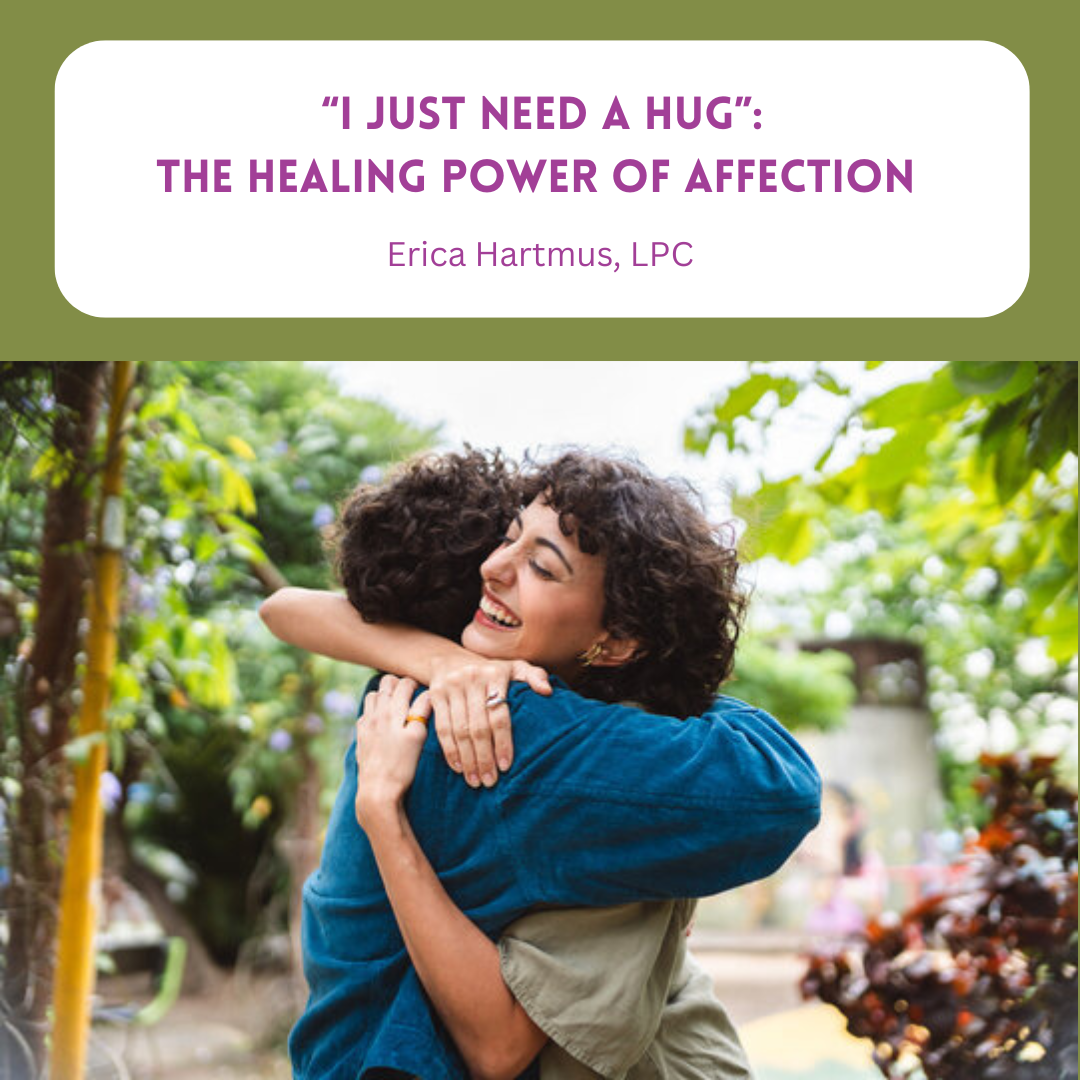“I Just Need a Hug”: The Healing Power of Affection
When I was in my early twenties, my roommate’s cat got spooked while I was holding him, and in his attempt to flee, he left me bleeding and in need of six stitches on my ear and near my eye. While I wasn’t afraid per se, I was a bit shaken up by the blood and drama of the situation, and my roommate, horrified, went into action mode. Together, we figured out a plan to get me to urgent care, and as she apologized profusely, I found myself holding back emotion, wanting to spare her from the sight of my tears in the hurricane of stress and guilt swirling around her. Working as a therapist in Chicago, I’ve noticed that moments like these—when life feels suddenly chaotic or out of control—often reveal just how much we crave simple, human connection.
I didn’t feel like crying because I was in pain. Sure, the cuts stung, but more than anything, I was feeling a lot of complex emotions at once. Anxiety, because I’d heard of cat scratches turning into far worse infections. Shame, because I felt partially responsible for not letting the cat go in time. And more than anything, a desire to be comforted. Amidst the chaos of figuring out what to do next, my inner child was left to fend for herself, afraid and alone, while my adult self tended to my roommate’s feelings and my own physical health. Looking back, the thing I needed most (besides medical treatment, of course) was a hug.
What Affection Does to the Nervous System
Humans don’t like to feel isolated. There’s safety in numbers, and when we are going through something challenging, the presence of another person can change the way we cope. Think about our most basic human instincts. Alone, we might not be able to weather a bad storm, fight off a predator, or collect enough food and water to survive. Even one other person could make all the difference between life or death.
Now, more often than not, our daily challenges are not “survival” threats, but emotional ones. Think about a child climbing into a parent’s lap after a nightmare. The child isn’t in genuine danger, but the affection of a parent is the first thing they seek. Their fear doesn’t vanish instantly, but their body relaxes in the safety of that embrace. Affectionate touch or presence does more than just provide comfort, it actually impacts our biology. When we receive affection, our nervous system regulates, feeling less of a threat than before.
The Science
The biological impact affection can have may be different depending on the situation, but here are some basics:
A Release of Oxytocin: Often nicknamed the “bonding hormone,” oxytocin is released when we hug, cuddle, or even when we make eye contact. Oxytocin creates a sense of trust, reduces fear, and creates that sense of connection.
Stress Relief: Affection also helps to lower cortisol, which is the body’s main stress hormone. In the wild, cortisol helps us react and respond to danger, but in day-to-day life, it often just leaves us feeling anxious and exhausted as we race to meet deadlines and handle daily stress. Affection works to help reduce the negative side effects of cortisol, making our body feel safe so it can lower its defenses and produce less as a result.
Vagus Nerve Activation: The vagus nerve acts as the brain and body’s main form of communication. When the body is in danger, the vagus nerve sends communication both ways. It tells the brain to be on high alert, ready to think fast and problem solve, and it tells the body to be prepared to fight, freeze, or flee. In contrast, when we feel safe, the vagus nerve also activates, telling the body to lower its heart rate, regulate breathing, and rest, digest, and connect.
Trauma-Informed Affection
I love a good hug, head scratch, or a pat on the back, but I’m aware that some aren’t as touchy. Whether it's a sensory issue, a bad memory, or simply a personal preference, affection can feel unsafe to many people. So what can you do to still get the physiological benefits when you’re not “a hugger”?
In our Chicago therapy practice, we often see clients who struggle with affection after trauma, cultural conditioning, or long periods of emotional isolation. If you’ve experienced trauma, inconsistent caregiving, or unwanted touch, your nervous system might not automatically register affection as soothing. Instead, it may automatically revert back to an unsafe memory whenever someone else begins to touch you. For these people, even well-intentioned bids for affection can sometimes trigger alarm.
If you relate to this, remember that there is no shame in needing some extra space. Your body has been trained to protect you, and, unfortunately, social norms are not always trauma-informed. Know that your wellbeing and physical safety comes before someone else’s feelings when you’re setting boundaries around touch.
If you’re happy with your relationship to affection, by no means do you need to test yourself. Instead, seek out other ways to regulate and soothe, like breathing exercises, audio or visual sensation seeking, or even self-touch. But, if you’d like to increase your tolerance to affection for any reason, (maybe you’re having kids, or in a relationship with someone who loves physical touch) start by taking it slow. Practice safe touch on your own or with a partner, examining which areas of the body are safe zones, what level of pressure feels best. Over time, tiny moments of affection can retrain the nervous system to recognize connection as supportive instead of threatening. Remember to take it slow and safe, honoring your limits, and reminding yourself that there’s nothing to be ashamed of when it comes to personal preference. Sometimes it’s helpful to have a trauma informed therapist to help you navigate all of this, too.
Incorporating More Affection
For huggers and non-huggers alike, there are many ways to benefit from the healing powers of affection in day-to-day life. Let’s examine a few:
Offer and Ask: It might feel awkward to ask for something that is usually offered, but normalizing physical touch, if you are someone who craves it, will only make your life better. Asking “Can I have a hug?” can feel vulnerable, but it also teaches us that our needs matter. Just make sure you are respecting other people’s touch boundaries when doing so, and try to avoid pressuring someone who seems uncomfortable, or who you don’t have an existing safe relationship with.
Non-Touch Affection: Remember: Not all affection requires physical touch. Eye contact, words of affirmation, or simply sitting with someone in silence can all cue safety.
Self-Affection: One of my favorite ways of incorporating more affecting into my life is by showing it to myself! Try placing a hand over your heart, wrapping yourself in a blanket, or using slow, steady breaths to ground your body. Even alone, your body receives the same feeling of safety and peace.
Remember that no level of affection will feel better than honoring your needs. Physical affection has positive physical and psychological impacts on average, but that doesn’t mean that you won’t be triggered by it if you have a traumatic experience with physical touch. Listen to your body and your emotions, above all else.
Closing Reflection
Looking back at my younger self in that urgent care waiting room, anxious, sweaty, and fueled by adrenaline, I wish I had known that asking for a hug was a viable option. In times of disorder and chaos, it feels imperative to be strong and steady. But when things have calmed down, we’re allowed to embrace the emotions that come up. To remind ourselves that, whether we’re alone or surrounded by community, we’re still human beings. And sometimes, human beings need hugs.
If you’re in Chicago and want to explore safe, supportive ways to reconnect with your emotions or rebuild trust through healthy affection, our therapists at Balanced Awakening are here to help—in person or virtually.


